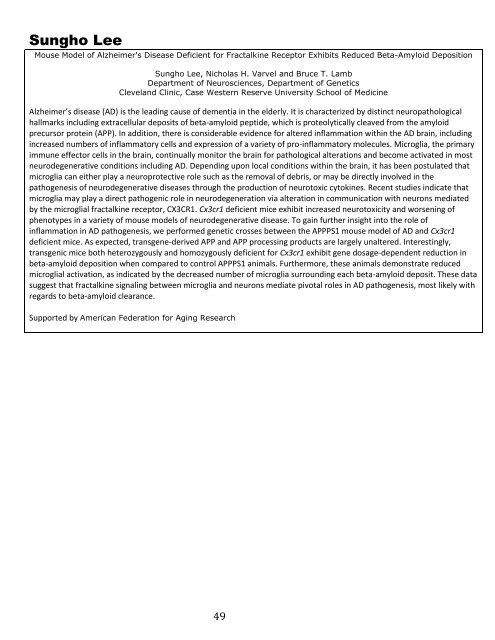student research day - Case Western Reserve University School of ...
student research day - Case Western Reserve University School of ...
student research day - Case Western Reserve University School of ...
You also want an ePaper? Increase the reach of your titles
YUMPU automatically turns print PDFs into web optimized ePapers that Google loves.
Sungho Lee<br />
Mouse Model <strong>of</strong> Alzheimer's Disease Deficient for Fractalkine Receptor Exhibits Reduced Beta-Amyloid Deposition<br />
Sungho Lee, Nicholas H. Varvel and Bruce T. Lamb<br />
Department <strong>of</strong> Neurosciences, Department <strong>of</strong> Genetics<br />
Cleveland Clinic, <strong>Case</strong> <strong>Western</strong> <strong>Reserve</strong> <strong>University</strong> <strong>School</strong> <strong>of</strong> Medicine<br />
Alzheimer’s disease (AD) is the leading cause <strong>of</strong> dementia in the elderly. It is characterized by distinct neuropathological<br />
hallmarks including extracellular deposits <strong>of</strong> beta-amyloid peptide, which is proteolytically cleaved from the amyloid<br />
precursor protein (APP). In addition, there is considerable evidence for altered inflammation within the AD brain, including<br />
increased numbers <strong>of</strong> inflammatory cells and expression <strong>of</strong> a variety <strong>of</strong> pro-inflammatory molecules. Microglia, the primary<br />
immune effector cells in the brain, continually monitor the brain for pathological alterations and become activated in most<br />
neurodegenerative conditions including AD. Depending upon local conditions within the brain, it has been postulated that<br />
microglia can either play a neuroprotective role such as the removal <strong>of</strong> debris, or may be directly involved in the<br />
pathogenesis <strong>of</strong> neurodegenerative diseases through the production <strong>of</strong> neurotoxic cytokines. Recent studies indicate that<br />
microglia may play a direct pathogenic role in neurodegeneration via alteration in communication with neurons mediated<br />
by the microglial fractalkine receptor, CX3CR1. Cx3cr1 deficient mice exhibit increased neurotoxicity and worsening <strong>of</strong><br />
phenotypes in a variety <strong>of</strong> mouse models <strong>of</strong> neurodegenerative disease. To gain further insight into the role <strong>of</strong><br />
inflammation in AD pathogenesis, we performed genetic crosses between the APPPS1 mouse model <strong>of</strong> AD and Cx3cr1<br />
deficient mice. As expected, transgene-derived APP and APP processing products are largely unaltered. Interestingly,<br />
transgenic mice both heterozygously and homozygously deficient for Cx3cr1 exhibit gene dosage-dependent reduction in<br />
beta-amyloid deposition when compared to control APPPS1 animals. Furthermore, these animals demonstrate reduced<br />
microglial activation, as indicated by the decreased number <strong>of</strong> microglia surrounding each beta-amyloid deposit. These data<br />
suggest that fractalkine signaling between microglia and neurons mediate pivotal roles in AD pathogenesis, most likely with<br />
regards to beta-amyloid clearance.<br />
Supported by American Federation for Aging Research<br />
49
















